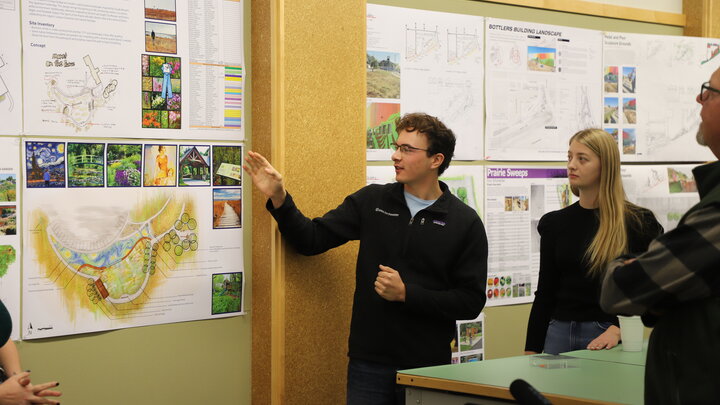A Partnership between University of Nebraska-Lincoln, Lincoln Public Schools, and the Natural Resources District
Landscape design plays a vital role in creating aesthetically pleasing and functional outdoor spaces. When local institutions partner with academic programs on new projects, they spark fresh ideas and innovative solutions. In an ongoing collaboration, University of Nebraska-Lincoln (UNL) students are developing landscape designs for two sites: the Bottler's Building, owned by Lincoln Public Schools (LPS), and a Lower Platte North Natural Resources District (LPNNRD) building under construction near Lake Wanahoo.
UNL's College of Agricultural Sciences and Natural Resources (CASNR) offers a Planting Design class through its agronomy and horticulture department. The course teaches students practical landscape architecture, plant selection, and site design. Under UNL Professor and Extension Landscape Horticulture Specialist, Kim Todd's guidance, students gain hands-on experience by creating concept renderings for local organizations.
Todd explains, “These partnerships are so vital to these student’s education, because they are developing landscapes for an actual site in need. The creative nature of young people in school, when they are allowed to do this, and think beyond the rigid program statement, gets their ideas our there, and usually makes a project a lot richer.”
Bottler's Building: Blending Functionality and Aesthetics
The Bottler's Building near Capitol Parkway and J Street poses an interesting design challenge. LPS purchased this longtime home of the Arts & Humanities Focus Program in 2022. As interior renovations near completion, focus has shifted to the building's landscape. The site's narrow planting strips along a bike path require creative solutions to maximize space while meeting practical needs.
LPS Director of Operations Scott Wieskamp enlisted Professor Todd's expertise for the exterior redesign. The landscape must balance multiple needs—parking spaces, student drop-off zones, and bus routes—while creating an inviting atmosphere for students and visitors.
Lower Platte North Natural Resources District: Integrating Nature and Education
The LPNNRD project involves designing landscapes for their new facility near Lake Wanahoo, Nebraska. Assistant General Manager Ryan Chapman reached out to his former professor, to involve her students. The site presents distinct challenges, including a steep 40- to 50-foot slope and a storm-water capture area. These elements must be thoughtfully incorporated to create both functional and educational spaces.
“The students got to go out and visit the site currently under construction. The students divided the site around the building into sections, went into teams to share ideas, this is a collaborative world, and certainly the design teams need to collaborate.” stated Todd.
Chapman sees great potential in the collaboration, noting, "This is a great opportunity for us to work with Kim and her students to conceptualize how we can utilize this space to engage the community and create future educational opportunities for folks" Beyond aesthetics, the design will serve as a teaching tool for sustainable practices like water conservation and erosion control—key principles in modern landscape architecture.
Real-World Applications and Educational Opportunities
For their final project, the students presented their landscape design renderings to clients, fielding questions and receiving feedback on implementation and practicality.
Chapman was thrilled with the final result, stating, “I really did not expect to see some of the final designs at this stage, all of the coloring and visuals, so they have done a ton of work in the last couple weeks, and we are vey impressed with the effort and creativity they put into it.”
These projects give UNL students valuable real-world experience. They learn that landscape design extends beyond plant selection to shape how people interact with outdoor spaces. They not only create better spaces but also prepare students for successful careers through practical experience.
This partnership between UNL, LPS, and LPNNRD exemplifies how universities and local organizations can collaborate to enhance public spaces. Through innovative landscape solutions, the students' work will leave a lasting mark on their community, while highlighting landscape design's essential role in shaping public spaces.




